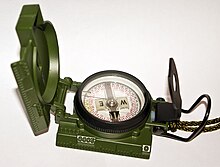Cammenga
| Company type | Private |
|---|---|
| Industry | Tritium navigation; tactical weaponry |
| Founded | 1992, Holland, Michigan, U.S. |
| Headquarters | Dearborn, Michigan, U.S. |
Area served | Worldwide |
| Products | Lensatic Compass; EasyLoader; EasyMag; Beta Blades |
Number of employees | 40 — July 2009 |
| Website | http://www.cammenga.com/ |
Cammenga is an outdoors products company, known chiefly for producing navigation equipment under contract for United States Armed Forces. They are the official supplier of the M-1950 lensatic field compass issued to U.S. Army and Marine Corps infantry and artillery units.
Profile[edit]
Cammenga was founded in 1992 by a group of investors to produce the M-1950 3H lensatic compass to the U.S. Armed Forces. Since 1992, Cammenga has held the U.S. military contract for the M-1950. The firm develops, manufactures, and distributes a wide variety of products to military, law enforcement, and commercial markets around the world, including land navigation instruments, firearm sighting and loading systems, firearm magazines, tritium knives, and other tritium light source integration services. The company provides development assistance in tritium (self-luminous) lighting products, NRC approval processing, tritium capsule assembly and installation procedures, and product testing. The company is ISO 9001:2000 certified.
Manufacturing facility[edit]
Cammenga's primary production plant includes a clean room environment for the assembly and testing of tritium products and critical devices. The company provides Cammenga assists with tritium product design, NRC approval processing, tritium installation, and product testing.
U.S. M-1950 3H Lensatic Compass[edit]

The M-1950 U.S. military lensatic field compass with self-luminous lighting (designated the Model 3H by Cammenga) is fitted with self-luminous tritium vial lighting. Under U.S. military specification (MIL-SPEC) performance criteria, ten pre-production samples of the M-1950 are required to meet a battery of performance, durability, and accuracy standards.[1] This includes an overall inherent accuracy standard of ±40 mils (2.25 degrees) from actual magnetic azimuth;[1][2] a tritium illumination test;[3] and a shock or impact test, in which samples of the M-1950 are tested dropping the compass from a height of 90 cm (35 in.) on a solid surface covered with 10 cm (4 in.) of plastic-covered sand,[4] followed by testing to ensure performance within specified accuracy standards.[1][5] A water leakage test is also performed.[1][6]
See also[edit]
References[edit]
- ^ a b c d Article MIL-PRF-10436N, rev. 31 October 2003, Washington, D.C.: U.S. Dept. of Defense
- ^ U.S. MIL-PRF-10436N:Performance Specification, Compass, Magnetic, Unmounted, 31 OCT 2003: 3.4.9.3. Compass error. The error in magnetic azimuth, including that caused by pivot friction, shall not be greater than 40 mils (see 4.4.1.8). 3.4.9.4 Friction error. The error caused by friction between the pivot supporting the dial and its bearing shall not be greater than 20 mils (see 4.4.1.9.3).
- ^ U.S. MIL-PRF-10436N:Performance Specification, 3.4.10: Illumination. The compass shall have internal, self-exciting light sources of constant luminosity for sighting and reading.
- ^ U.S. MIL-PRF-10436N: Performance Specification 4.4.3.4, Durability. The compass in the open configuration, if applicable, shall be dropped from a height of 90 cm, alternately on its face, side and bottom, onto a solid surface covered with 10 cm of 40 grit kiln-dried sand. The sand may be covered with a sheet of plastic not greater than 2 mils thick.
- ^ MIL-PRF-10436N, Performance Specification, 4.4.3.4 Durability. e. After each drop, alternating targets, sight the compass on one of three targets of known magnetic azimuths approximately 120° apart and record each reading. f. After every tenth drop test the compass for friction error as defined in 4.4.1.9.3
- ^ MIL-PRF-10436N, Performance Specification, 4.4.2.1: Water leakage. The complete compass shall be submerged in 300 ml of distilled or deionized water for 24 hours at 23° ±5°C. The compass shall be removed from the water and examined for water leakage. If there is evidence of water in the compass bowl at the completion of the test, it shall constitute failure of this test.
